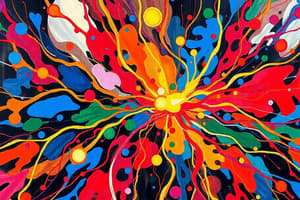Podcast
Questions and Answers
What is the main cause of fatigue according to the provided information?
What is the main cause of fatigue according to the provided information?
- Inadequate oxygen supply
- Accumulation of lactic acid (correct)
- Decreased ATP levels
- Low glycogen levels
What effect does moderate frequency stimulation have on muscle contractions?
What effect does moderate frequency stimulation have on muscle contractions?
- Causes complete muscle fatigue
- Leads to clonus (correct)
- Produces separate muscle twitches
- Results in sustained contraction only
How does cooling affect muscle stimulation and the associated curves?
How does cooling affect muscle stimulation and the associated curves?
- Converts muscle twitches to separate contractions
- Increases muscle twitch intensity
- Reduces the frequency of muscle twitches (correct)
- Promotes transition to tetanus
What phenomenon is associated with high frequency stimulation of muscles?
What phenomenon is associated with high frequency stimulation of muscles?
What effect does warming have on muscle stimulation as per the content provided?
What effect does warming have on muscle stimulation as per the content provided?
What happens to sodium ion permeability during the neuromuscular transmission process?
What happens to sodium ion permeability during the neuromuscular transmission process?
Which phase of a simple muscle twitch corresponds to the time from stimulus onset to the beginning of contraction?
Which phase of a simple muscle twitch corresponds to the time from stimulus onset to the beginning of contraction?
What is the main physiological change in muscle response when it experiences fatigue?
What is the main physiological change in muscle response when it experiences fatigue?
How does warming affect a simple muscle twitch?
How does warming affect a simple muscle twitch?
What is the site of neuromuscular transmission?
What is the site of neuromuscular transmission?
Flashcards
Latent period
Latent period
The time lag between a stimulus and the beginning of muscle contraction; it reflects the time needed for:
-
Action potential conduction along the motor neuron to the neuromuscular junction (NMJ).
-
Synaptic transmission at the NMJ.
-
Action potential propagation across muscle membrane.
-
Excitation-contraction coupling.
Simple Muscle Twitch
Simple Muscle Twitch
A single, brief contraction of a muscle fiber followed by relaxation; it results from a single action potential.
Contraction Phase
Contraction Phase
The period of shortening of the muscle fibers.
Relaxation Phase
Relaxation Phase
Signup and view all the flashcards
Muscle Fatigue
Muscle Fatigue
Signup and view all the flashcards
Staircase Phenomenon
Staircase Phenomenon
Signup and view all the flashcards
Tetanus
Tetanus
Signup and view all the flashcards
Clonus
Clonus
Signup and view all the flashcards
Muscle Twitch
Muscle Twitch
Signup and view all the flashcards
Effect of Temperature on Muscle Contraction
Effect of Temperature on Muscle Contraction
Signup and view all the flashcards
Study Notes
Physiology Department - Cairo University
- Located at Kasr Alainy Medical School, Cairo University
- Focuses on the study of the functions of the human body
Skeletal Muscle Experiments
- Demonstrates various aspects of skeletal muscle function and stimulation
Neuromuscular Transmission
- Describes the process of communication between nerve and muscle cells
- Involves the neuromuscular junction, synaptic vesicles, and neurotransmitters
Neuromuscular Junction
- Detailed diagram illustrating components
- Includes axon terminal, synaptic vesicles, synaptic cleft, and muscle fiber
Arrival of A.P (Action Potential)
- Initiates the cascade of events in muscle contraction
- Triggers the opening of voltage-gated calcium channels
Release of ACh (Acetylcholine)
- Neurotransmitter released across the neuromuscular junction
- Stimulates muscle fiber contraction
Motor End Plate
- Region of muscle fiber receiving ACh (acetylcholine)
- Contains ACh receptors initiating muscle contraction
Simple Muscle Twitch
- Single muscle contraction followed by relaxation
- Result of a single maximal stimulus
Stages of Simple Muscle Twitch
- Latent period: Time from stimulus to contraction
- Contraction phase: Muscle shortening
- Relaxation phase: Muscle returning to resting length
- Recovery phase: Return to fully relaxed state
Latent Period Details
- Conduction of nerve impulse
- Synaptic delay (neuromuscular junction)
- Electrical and mechanical events in the muscle
- Tissue viscosity (resistance to stretching)
Effect of Temperature on Simple Muscle Twitch
- Warmed muscles react rapidly with larger, shorter responses.
- Cooled muscles react slower with reduced responses in strength and duration
Muscle Fatigue
- Causes:
- Acetylcholine depletion
- ATP depletion
- Glycogen depletion
- Oxygen supply problems
- Lactic acid buildup
Multiple Stimuli and Muscle Responses
- Low-frequency stimulation leads to separate muscle twitches.
- Moderate frequency generates clonus.
- High-frequency stimulation results in tetanus.
Clonus
- Rhythmic involuntary contractions and relaxations
Tetanus
- Sustained muscle contraction
Effect of Cooling/Warming
- Influences the amplitude and duration of stimulation and muscle response.
Graph Interpretation Questions
- Interpretation of graphs relating to muscle response, stimulation, and temperature effects is required.
Curve Identification
- Various graphs depicting aspects of muscle stimulation and response are discussed and identified by their labels.
Studying That Suits You
Use AI to generate personalized quizzes and flashcards to suit your learning preferences.
Related Documents
Description
Test your knowledge on the neuromuscular functions including the transmission process between nerve and muscle cells. Explore the roles of skeletal muscle, action potential, and acetylcholine in muscle contraction. This quiz will cover concepts relevant to the physiology department at Cairo University.




